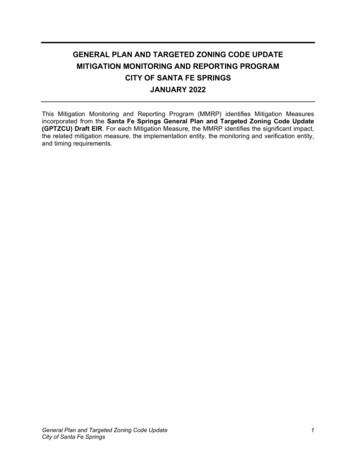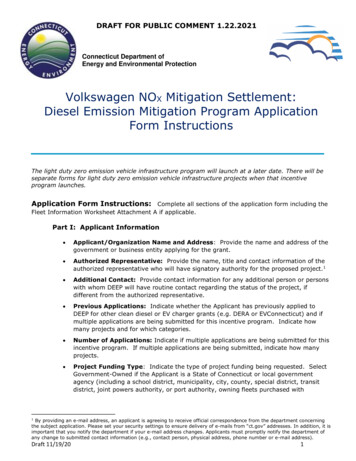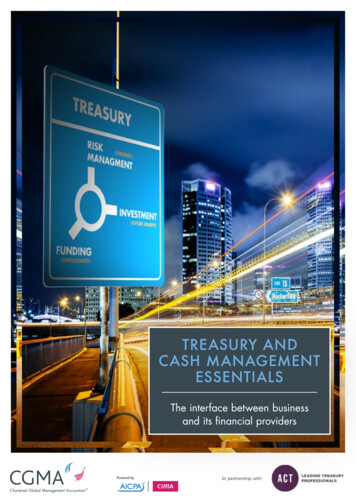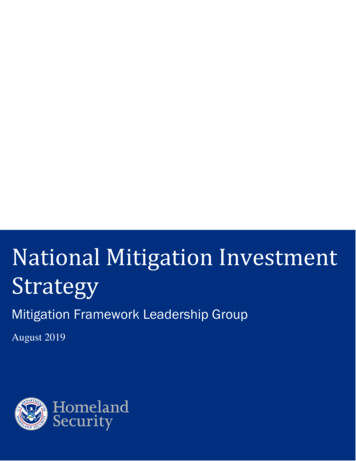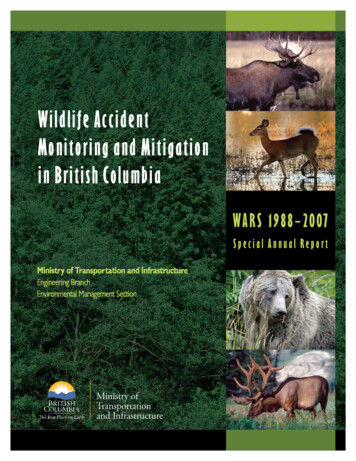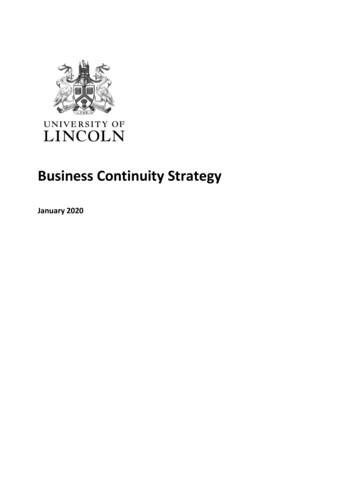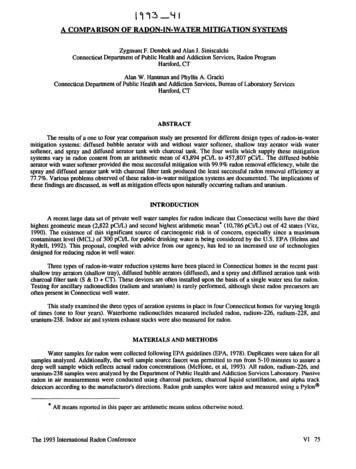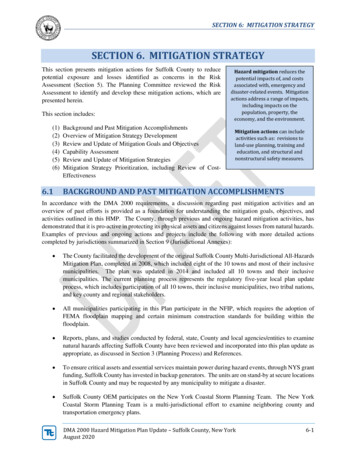
Transcription
SECTION 6: MITIGATION STRATEGYSECTION 6. MITIGATION STRATEGYThis section presents mitigation actions for Suffolk County to reducepotential exposure and losses identified as concerns in the RiskAssessment (Section 5). The Planning Committee reviewed the RiskAssessment to identify and develop these mitigation actions, which arepresented herein.This section includes:(1)(2)(3)(4)(5)(6)6.1Background and Past Mitigation AccomplishmentsOverview of Mitigation Strategy DevelopmentReview and Update of Mitigation Goals and ObjectivesCapability AssessmentReview and Update of Mitigation StrategiesMitigation Strategy Prioritization, including Review of CostEffectivenessHazard mitigation reduces thepotential impacts of, and costsassociated with, emergency anddisaster-related events. Mitigationactions address a range of impacts,including impacts on thepopulation, property, theeconomy, and the environment.Mitigation actions can includeactivities such as: revisions toland-use planning, training andeducation, and structural andnonstructural safety measures.BACKGROUND AND PAST MITIGATION ACCOMPLISHMENTSIn accordance with the DMA 2000 requirements, a discussion regarding past mitigation activities and anoverview of past efforts is provided as a foundation for understanding the mitigation goals, objectives, andactivities outlined in this HMP. The County, through previous and ongoing hazard mitigation activities, hasdemonstrated that it is pro-active in protecting its physical assets and citizens against losses from natural hazards.Examples of previous and ongoing actions and projects include the following with more detailed actionscompleted by jurisdictions summarized in Section 9 (Jurisdictional Annexes): The County facilitated the development of the original Suffolk County Multi-Jurisdictional All-HazardsMitigation Plan, completed in 2008, which included eight of the 10 towns and most of their inclusivemunicipalities. The plan was updated in 2014 and included all 10 towns and their inclusivemunicipalities. The current planning process represents the regulatory five-year local plan updateprocess, which includes participation of all 10 towns, their inclusive municipalities, two tribal nations,and key county and regional stakeholders. All municipalities participating in this Plan participate in the NFIP, which requires the adoption ofFEMA floodplain mapping and certain minimum construction standards for building within thefloodplain. Reports, plans, and studies conducted by federal, state, County and local agencies/entities to examinenatural hazards affecting Suffolk County have been reviewed and incorporated into this plan update asappropriate, as discussed in Section 3 (Planning Process) and References. To ensure critical assets and essential services maintain power during hazard events, through NYS grantfunding, Suffolk County has invested in backup generators. The units are on stand-by at secure locationsin Suffolk County and may be requested by any municipality to mitigate a disaster. Suffolk County OEM participates on the New York Coastal Storm Planning Team. The New YorkCoastal Storm Planning Team is a multi-jurisdictional effort to examine neighboring county andtransportation emergency plans.DMA 2000 Hazard Mitigation Plan Update – Suffolk County, New YorkAugust 20206-1
SECTION 6: MITIGATION STRATEGY Suffolk County applied for and received an HMPG grant from FEMA through the NY State Office ofEmergency Management to conduct a public education campaign on coastal hazards. Public meetingswere hosted by local County Legislators in the most at-risk areas of the County, and a public .html) was established for continued awareness ofnatural hazards and mitigation related information. Suffolk County FRES makes presentations regarding hurricane preparedness to local Chambers ofCommerce, communities, schools, and civic associations across Suffolk County. During the latesummer and fall periods approximately 10 – 15 presentations are given each month. In addition, SuffolkCounty FRES attends public meetings with local political figures to emphasize preparedness. Many municipalities in Suffolk County have adopted regulatory standards regarding land-use andzoning that exceed minimum requirements and provide the communities with greater capability tomanage development without increasing hazard risk and vulnerability. Examples of these standards arepresented in the Capability Assessment subsection later in this chapter. Municipalities have developed or leveraged programs to fund mitigation activities, including theformation of coastal erosion districts, the establishment and maintenance of “engineered beaches”, andproperty transfer fees to acquire high-risk property and preserve for open-space use. Municipalities have actively participated in available mitigation grant funding opportunities toimplement mitigation projects, including the New York Rising Hazard Mitigation Grant Program. The County and municipalities have implemented mitigation actions to protect critical facilities andinfrastructure throughout the planning area. Suffolk County, working along with the inclusive municipalities, conducts and facilitates communityand public education and outreach to promote and effect natural hazard risk reduction. The Suffolk County FRES has contracted with Emergency Communications Network to license it'sCodeRED high-speed notification system. The CodeRED emergency notification system is a high-speedmass notification service that allows the Suffolk Emergency Managers and Public Safety Officials todeliver customized messages directly to Suffolk County homes and business. The CodeRED systemalso sends out high-speed emails and text messages to those residents who have enrolled additionalcontact information.6.2GENERAL MITIGATION PLANNING APPROACHThe overall approach used to update the County and local hazard mitigation strategies are based on FEMA andNYS regulations and guidance regarding local mitigation plan development, including: DMA 2000 regulations, specifically 44 CFR 201.6 (local mitigation planning).FEMA Local Mitigation Planning Handbook, March 2013.FEMA Local Mitigation Plan Review Guide, October 1, 2011.FEMA Integrating Hazard Mitigation into Local Planning, March 1, 2013.FEMA Plan Integration: Linking Local Planning Efforts, July 2015.FEMA Mitigation Planning How-To Guide #3, Identifying Mitigation Actions and ImplementingStrategies (FEMA 386-3), April 2003.FEMA Mitigation Ideas: A Resource for Reducing Risk to Natural Hazards, January 2013.NYS DHSES New York State Hazard Mitigation Planning Standards, 2017.DMA 2000 Hazard Mitigation Plan Update – Suffolk County, New YorkAugust 20206-2
SECTION 6: MITIGATION STRATEGY NYS DHSES New York State Hazard Mitigation Planning Standards Guide, 2017.The mitigation strategy update approach includes the following steps that are further detailed in later sections ofthis section: 6.3Section 6.3 - Review and update mitigation goals and objectivesSection 6.4 - Identify mitigation capabilities and evaluate their capacity and effectiveness to mitigateand manage hazard riskSection 6.5 - Prepare an implementation strategy, including:o Identification of progress on previous county and local mitigation strategieso Development of updated county and local mitigation strategies, ando Prioritization projects and initiatives in the updated mitigation strategyREVIEW AND UPDATE OF MITIGATION GOALS AND OBJECTIVESThis section documents the efforts to update the guiding principle (missionstatement), and hazard mitigation goals and objectives established to reduceor avoid long-term vulnerabilities to the identified hazards.MISSION STATEMENTPer FEMA guidance (386-1), a mission statement or guiding principledescribes the overall duty and purpose of the planning process and serves toidentify the principle message of the plan. It focuses or constrains the rangeof goals and objectives identified. This is not a goal because it does notdescribe outcomes, rather it is broad in scope, and provides a direction forthe HMP update.During the original 2008 hazard mitigation planning process the MitigationPlanning Committee (MPC) developed a mission statement which was thenmaintained during the 2014 update. As part the of the 2020 update process,the Suffolk County Hazard Mitigation Steering Committee reviewed themission statement and elected to maintain it without edit or amendment, as:FEMA defines Goals as generalguidelines that explain whatshould be achieved. Goals areusually broad, long-term, policystatements, and represent aglobal vision.FEMA defines Objectives asstrategies or implementationsteps to attain mitigation goals.Unlike goals, objectives arespecific and measurable, wherefeasible.FEMA defines Mitigation Actionsas specific actions that help toachieve the mitigation goals andobjectives.Identify and reduce the vulnerability to natural hazards in order to protect the health, safety, quality of life,environment and economy of the communities within Suffolk County.6.4GOALS AND OBJECTIVESAccording to CFR 201.6(c)(3)(i): “The hazard mitigation strategy shall include a description of mitigation goalsto reduce or avoid long-term vulnerabilities to the identified hazards.” The Steering Committee developedmitigation goals and objectives based on the risk assessment results, discussions, research, and input fromamongst the committee, existing authorities, polices, programs, resources, stakeholders and the public.The original goals and objectives of the HMP were established by the MPC during the 2007-2008 planningprocess. The MPC identified eight goals through a facilitated exercise, working from a catalog of goal statementscreated through review of similar plans and FEMA planning guidance. Once the goals were established,objectives that meet multiple goals were selected through a similar facilitated exercise. For the purposes of thisplan, goals are defined as general guidelines that explain what is to be achieved. They are usually broad, longterm, policy-type statements and represent global visions. Goals help define the benefits that the plan is tryingDMA 2000 Hazard Mitigation Plan Update – Suffolk County, New YorkAugust 20206-3
SECTION 6: MITIGATION STRATEGYto achieve. The success of the plan, once implemented, should be measured by the degree to which its goals havebeen met (that is, by the actual benefits in terms of hazard mitigation).The Suffolk County goals are compatible with the needs and goals expressed in other available communityplanning documents as well as the NYS HMP. Achievement of these goals helps to define the effectiveness ofa mitigation strategy.Objectives were then updated by the Steering Committee through its knowledge of the local area, review of pastefforts, findings of the risk assessment, qualitative evaluations, and identification of mitigation options. Theobjectives are used to 1) measure the success of the plan once implemented, and 2) to help prioritize identifiedmitigation actions. For the purposes of this plan, objectives are defined as follows:Objectives are short-term aims which, when combined, form a strategy or course of action to meet a goal. Unlikegoals, objectives are a stand-alone measurement of the effectiveness of a mitigation action, rather than as a subsetfor a goal. The objectives also are used to help establish priorities.The Steering Committee selected objectives that would meet multiple goals. The objectives serve as a standalone measurement of a mitigation action, rather than as a subset of a goal. Achievement of the objectives willbe a measure of the effectiveness of a mitigation strategy. The objectives also are used to help establish priorities.During the 2020 plan update process, the Steering Committee reviewed the 2014 goals and objectives. Further,all participating jurisdictions were provided a Goals and Objectives worksheet to facilitate their input to theupdate process. The 2014 goals and objectives were reviewed in consideration of the hazard events and lossessince the 2014 plan, the updated hazard profiles and vulnerability assessment, the goals and objectivesestablished in the other related State, county and local risk management plans, as well as direct input on how theCounty and municipalities recognize they need to move forward to best manage their hazard risk. Amendmentsinclude additions/edits to goals and/or objectives to express the planning partnership’s interests in integratingthis plan with other planning mechanisms/programs, and to support mitigation through the protection andpreservation of natural systems, including particular reference to certain goals and objectives in the NYS 2019HMP update as identified in the table below.As a result of this review process, the Goals and Objectives for the 2019 update have been amended, as presentedin Table 6-1 and Table 6-2. Red text indicates the updates for this plan.Table 6-1. Suffolk County Hazard Mitigation Plan GoalsGoalNumberGoal StatementG-1Save lives and reduce injury.G-2Avoid, minimize or reduce damage to property including but not limited to critical facilities, lifelines,infrastructure and those properties known to receive or experience repetitive damages.G-3Reduce exposure to risk, while protecting or restoring natural processes to the maximum extent possible.G-4Consider the wise uses of land in known or identified hazard areas.G-5Encourage the development and implementation of sustainable, long-term, cost-effective and environmentallysound mitigation projects.G-6Promote hazard mitigation awareness and education throughout the county.G-7Improve community emergency management capability (i.e., prepare, respond, recover, mitigate).G-8Maintain economic viability after a hazard event.DMA 2000 Hazard Mitigation Plan Update – Suffolk County, New YorkAugust 20206-4
SECTION 6: MITIGATION STRATEGYTable 6-2. Suffolk County Hazard Mitigation Plan -9O-10Objective StatementEnhance the public’s understanding of natural hazards, the risk they pose and ways to mitigate those impacts.Retrofit, acquire, or relocate structures in high hazard areas, including but not limited to those known to be orsubject to repetitive damages.Continually improve understanding of the location and potential impacts of natural hazards, the vulnerability ofbuilding types, and community development patterns and the measures needed to protect life safety at the localgovernment level.Strengthen codes so that new construction can withstand the impacts of natural hazards and lessen the impact ofthat development on the environment’s ability to absorb the impact of natural hazards.Seek projects that minimize or mitigate their impact on the environment or protect natural/cultural resources thatserve a natural hazard mitigation function including but not limited to: beach nourishment, stream channelrestoration, and wetlands creation/preservationReplace objective with: Encourage new development outside of hazard prone areas.Establish a partnership among all levels of government and the business community to improve and implementmethods to protect life and property.Develop and implement wildfire mitigation and watershed protection strategies that reduce losses to habitat andprotect water while also reducing damage to development.Increase enrollment and support of the CRS program in order to lower cost of flood insurance premiums.O-12Protect against the negative impacts of invasive species.Implement water conservation measures, use reclaimed water, and increase more prudent groundwater usage,create surface water storage where appropriate.Develop or improve early warning emergency response systems and evacuation procedures.O-13Work to lower emergency service response times, including improvement to transportation facilities.O-14O-18Seek to integrate/coordinate all phases of Emergency Management within the planning area.Seek mitigation projects that provide the highest degree of natural hazards protection at the least cost byconsidering projects that will mitigate the impacts of multiple hazards and/or leverage multiple funding sources.Increase resilience of critical facilities, lifelines, infrastructure, agriculture, and aquaculture.Implement stormwater best management practices and seek to implement identified stormwater managementactivities and projects, including securing needed funding.Strengthen understanding of, and adaptation to, a changing climate.O-19Support and enroll the Tribal Nations in the National Flood Insurance Program.O-11O-15O-16O-17DMA 2000 Hazard Mitigation Plan Update – Suffolk County, New YorkAugust 20206-5
SECTION 6: MITIGATION STRATEGYTable 6-3. Suffolk County Hazard Mitigation Plan ObjectivesObj. #Objective 8O-1Enhance the public’s understanding of hazards, the risk they pose and ways to mitigate thoseimpacts.O-2Retrofit, acquire, or relocate structures in high hazard areas, including but not limited to thoseknown to be or subject to repetitive damages.O-3Continually improve understanding of the location and potential impacts of hazards, thevulnerability of building types, and community development patterns and the measures neededto protect life safety at the local government level.O-4Strengthen codes so that new construction can withstand the impacts of hazards and lessen theimpact of that development on the environment’s ability to absorb the impact of natural hazards.O-5Seek projects that minimize or mitigate their impact on the environment or protectnatural/cultural resources that serve a natural hazard mitigation function including but notlimited to: beach nourishment, stream channel restoration, and wetlands creation/preservationXO-6Replace objective with: Encourage new development outside of hazard prone areas.XO-7Establish a partnership among all levels of government and the business community to improveand implement methods to protect life and property.O-8Develop and implement wildfire mitigation and watershed protection strategies that reducelosses to habitat and protect water while also reducing damage to development.O-9Increase enrollment and support of the CRS program in order to lower cost of flood insurancepremiums.O-10Protect against the negative impacts of invasive species.O-11Implement water conservation measures, use reclaimed water, and increase more prudentgroundwater usage, create surface water storage where appropriate.O-12Develop or improve early warning emergency response systems and evacuation procedures.XXXO-13Work to lower emergency service response times, including improvement to transportationfacilities.XXXO-14Seek to integrate/coordinate all phases of Emergency Management within the planning area.XXO-15Seek mitigation projects that provide the highest degree of hazards protection at the least costby considering projects that will mitigate the impacts of multiple hazards and/or leveragemultiple funding sources.XXO-16Increase resilience of critical facilities, lifelines, infrastructure, agriculture, and aquaculture.XO-17Implement stormwater best management practices and seek to implement identified stormwatermanagement activities and projects, including securing needed funding.XDMA 2000 Hazard Mitigation Plan Update – Suffolk County, New YorkAugust 2020XXXXXXXXXXXXXXXXXXXXXXXXXXXXXXXXXXXXXXX6
SECTION 6: MITIGATION STRATEGYGoal1Goal2Goal3Strengthen understanding of, and adaptation to, a changing climate. (New objective for the 2020update)XXSupport and enroll the Tribal Nations in the National Flood Insurance Program. (New objectivefor the 2020 update)XXObj. #Objective StatementO-18O-19DMA 2000 Hazard Mitigation Plan Update – Suffolk County, New YorkAugust 2020Goal4Goal5Goal6XXXXXXGoal7Goal87
SECTION 6: MITIGATION STRATEGY6.5CAPABILITY ASSESSMENTAccording to the FEMA Mitigation Planning How-To Guide #3, a capability assessment is an inventory of acommunity’s missions, programs and policies; and an analysis of its capacity to carry them out. This assessmentis an integral part of the planning process. The assessment process enables identification, review and analysisof local and state programs, policies, regulations, funding and practices currently in place that may eitherfacilitate or hinder mitigation.During the original planning process, the County and all jurisdictions identified and assessed their capabilitiesin the areas of planning and regulatory, administrative and technical, and fiscal. By completing this assessment,the Planning Committee and each jurisdiction learned how or whether they would be able to implement certainmitigation actions by determining the following: Limitations that may exist on undertaking actions;The range of local and/or state administrative, programmatic, regulatory, financial and technicalresources available to assist in implementing their mitigation actions;Actions deemed infeasible as they are currently outside the scope of capabilities;Types of mitigation actions that may be technically, legally (regulatory) administratively, politically orfiscally challenging or infeasible;Opportunities to enhance local capabilities to support long term mitigation and risk reduction.During the 2020 plan update process, all participating jurisdictions were tasked with developing or updatingtheir capability assessment, paying particular attention to evaluating the effectiveness of these capabilities insupporting hazard mitigation, and identifying opportunities to enhance local capabilities.County, municipal and tribal capabilities in the areas of planning and regulatory, administrative and technical,and fiscal may be found in the Capability Assessment section of their jurisdictional annexes in Section 9.Further, participating jurisdictions have identified how they have integrated hazard risk management into theirexisting planning, regulatory and operational/administrative framework (“integration capabilities”), and howthey intend to promote this integration (“integration actions”). A list of planning documents reviewed forintegration is included in Appendix G. A further summary of these continued efforts to develop and promote acomprehensive and holistic approach to hazard risk management and mitigation is presented in Section 7 – PlanMaintenance.A summary of the various federal, state, county and local planning and regulatory, administrative and technical,and fiscal programs available to promote and support mitigation and risk reduction in Suffolk County arepresented below.PLANNING AND REGULATORY CAPABILITIES-STATE AND FEDERALNational Flood Insurance ProgramThe U.S. Congress established the NFIP with the passage of the National Flood Insurance Act of 1968 (FEMA’s2002 National Flood Insurance Program (NFIP): Program Description). The NFIP is a Federal program enablingproperty owners in participating communities to purchase insurance as a protection against flood losses inexchange for State and community floodplain management regulations that reduce future flood damages.There are three components to the NFIP: flood insurance, floodplain management and flood hazard mapping.Communities participate in the NFIP by adopting and enforcing floodplain management ordinances to reducefuture flood damage. In exchange, the NFIP makes federally backed flood insurance available to homeowners,DMA 2000 Hazard Mitigation Plan Update – Suffolk County, New YorkAugust 20206-8
SECTION 6: MITIGATION STRATEGYrenters, and business owners in these communities. Community participation in the NFIP is voluntary. Floodinsurance is designed to provide an alternative to disaster assistance to reduce the escalating costs of repairingdamage to buildings and their contents caused by floods. Flood damage in the U.S. is reduced by nearly 1billion each year through communities implementing sound floodplain management requirements and propertyowners purchasing flood insurance. Additionally, buildings constructed in compliance with NFIP buildingstandards suffer approximately 80% less damage annually than those not built in compliance (FEMA 2008).Suffolk County and the majority of the County’s individual jurisdictions actively participate in the NFIP. TheUnkechaug Tribal Nation is actively working to join the NFIP and has identified joining the NFIP as a mitigationaction. As of July 2020, there were 31,664 NFIP policyholders in Suffolk County. There have been 31,759claims made, totaling over 1 billion for damages to structures and contents. There are 3,681 NFIP RepetitiveLoss (RL) properties in the County. Severe Repetitive Loss (SRL) data was unavailable for this plan update.Further details on the County’s flood vulnerability may be found in the flood hazard profile in Section 5.Municipal participation in and compliance with the NFIP is supported at the Federal level by FEMA Region IIand the Insurance Services Organization (ISO), at the state-level by the New York State Department ofEnvironmental Conservation (NYSDEC) and New York State Office of Emergency Management (NYSOEM).Additional information on the NFIP program and its implementation throughout the County may be found in theflood hazard profile (Section 5) and each jurisdiction’s annex (Volume II Section 9).The State and communities may adopt higher regulatory standards when implementing the provisions of theNFIP. Specifically identified are the following:Freeboard: By law, NYS requires base flood elevation plus 2 feet (BFE 2) for all new construction. Whenthere is a base flood elevation available, the lowest floor including any basement, must be at or above the baseflood elevation (plus two feet beginning in 2007). Elevation may be by means of properly compacted fill, a solidslab foundation, or a "crawl space" foundation which contains permanent openings to let flood waters in and out.Non-residential structures may be flood proofed in lieu of elevation. Where a local floodplain administrator hasinformation to estimate a base flood elevation, such as historic flood records or a hydraulic study, that elevationmust be used. If the development consists of more than 5 acres or more than 50 lots, the permit applicant mustdevelop a base flood elevation and build accordingly (NYSDEC 2007). Communities may go beyond thisrequirement, providing for additional freeboard. In most New York communities, new structures must have thelowest floor three feet or more above the highest adjacent grade.Cumulative Substantial Improvements/Damages: The NFIP allows improvements valued at up to 50% ofthe building’s pre-improvement value to be permitted without meeting the flood protection requirements. Overthe years, a community may issue a succession of permits for different repairs or improvement to the samestructures. This can greatly increase the overall flood damage potential for the structure and within a community.The community may wish to deme “substantial improvement” cumulatively so that once a threshold ofimprovement within a certain length of time is reached, the structure is considered to be substantially improvedand must meet flood protection requirements.Limit of Moderate Wave Action (LiMWA): LiMWA depicts the Limit of the Area of Moderate Wave Action(MOWA), the portion of the 1% annual chance coastal flood hazard area referenced by building codes andstandards, where base flood wave heights are between 1.5 and 3 feet, and where wave characteristics are deemedsufficient to damage many NFIP-compliant structures on shallow or solid wall foundations. Coastalcommunities may adopt what is commonly referred to as the “LiMWA standard” where they enforce “V zone”construction standards within coastal LiMWA “A zones”.DMA 2000 Hazard Mitigation Plan Update – Suffolk County, New YorkAugust 20206-9
SECTION 6: MITIGATION STRATEGYNFIP Community Rating System (CRS)As an additional component of the NFIP, the Community Rating System (CRS) is a voluntary incentive programthat recognizes and encourages community floodplain management activities that exceed the minimum NFIPrequirements. As a result, flood insurance premium rates are discounted to reflect the reduced flood risk resultingfrom the community actions meeting the three goals of the CRS: (1) reduce flood losses; (2) facilitate accurateinsurance rating; and (3) promote the awareness of flood insurance (FEMA 2017).Currently no communities in Suffolk County participate in CRS. In the past, the Town of Southampton and theVillages of Babylon, Brightwaters, Northport and Southampton were involved in the program at Class 10 ratings.The status of these communities has since been “rescinded” and they receive no discount.Towns, Villages, and the County as a whole could expect significant cost savings on premiums if enrolled in theCRS program.U. S. Army Corps of EngineersUnder Section 404(e) of the Clean Water Act, the U.S. Army Corps of Engineers (USACE) can issue generalpermits to authorize activities that have only minimal individual and cumulative adverse environmental effects.A nationwide permit (NWP) is a general permit that authorizes activities across the country, unless a district ordivision commander revokes the nationwide permit in a state or other geographic region. There are 54 nationwidepermits, and they authorize a wide variety of activities, including: linear transportation projects, bankstabilization activities, residential development, commercial and industrial developments, aids to navigation andcertain maintenance activities (USACE 2020). Details on each NWP can be found atory/Regional-General-Permits/There are three types of USACE permits: standard, nationwide (described above), and regional. Standard permitsare individual permits that involve full public interest review of an individual permit application and includesthe issuance of a public notice for any project that does not meet the term
Suffolk County, working along with the inclusive municipalities, conducts and facilitates community and public education and outreach to promote and effect natural hazard risk reduction. The Suffolk County FRES has contracted with Emergency Communications Network to license it's CodeRED high-speed notification system.
